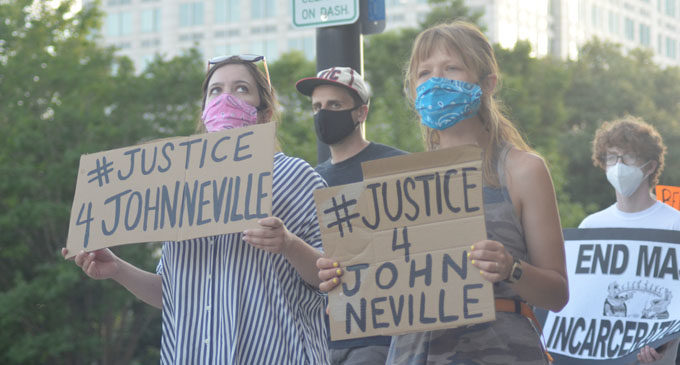Body camera footage raises more questions than answers
Demonstrators march through the street demanding justice for John Neville.

I’m not sure what I was expecting when I watched the body camera footage, but I do know after watching John Neville tell sworn officers of the law and a registered nurse nearly 30 times “I can’t breathe,” I have more questions now then I had before. Why is it OK to put a man in a restraint chair after he suffered a seizure? Did it take five officers to handle a 56-year-old man who just had a seizure? Why would you leave a man hogtied face down on a mattress after he appears to be unresponsive?
The videos released last week shows what happened the morning of Dec. 2, 2019, after Neville fell from the top bunk onto the floor of his cell in the Forsyth County Jail. The footage begins with the nurse kneeling next to Neville who is lying on his back and is unresponsive.
While kneeling, the nurse tells Neville “It’s OK” and “You’re OK” several times before he seems to regain consciousness. At which point the nurse tells Neville “It looks like you had a seizure.” As the nurse tries to check his blood pressure, Neville tries to get up. An officer tells Neville he’s having a medical issue and tells him to calm down several times, while other officers tried to stop him from getting up as well. As he fights to get up Neville yells “Let me up” and “Help me” several times.
After struggling to keep Neville restrained for about two minutes, an officer can be heard saying “He’s trying to bite,” (which I never saw) and requests a transport/restraint chair. A few seconds later, the group of officers turn Neville on his stomach, handcuff his hands behind his back, and put a white cloth over his head commonly used to stop inmates from spitting or biting.
Once he’s handcuffed, Neville is moved to the restraint chair and transported to an observation cell, where he was placed faced down on a mattress. While still being restrained by four other officers with the Forsyth County Sheriff’s Office, another officer tries to remove the handcuffs when Neville begins crying out for help.
Combined, Neville told officers “Help me” and “I can’t breathe” more than 50 times. In response, officers tell Neville to relax. At one point one officer can be heard saying “If you can talk, you can breathe,” and at another point “You can breathe because you’re talking, you’re yelling and you’re moving.” At some point, the key to remove the handcuffs breaks and an officer requests bolt cutters as Neville’s voice begins to fade.
By the time the bolt cutters are brought in, Neville is already not moving. After the bolt cutters don’t work, an officer asks every officer in the cell who is still restraining Neville by holding his legs, “Are you OK?” but doesn’t even recognize the man who has been crying for help for the last 10 minutes and who isn’t even moving anymore. One officer even found time to make a joke about who would pay for the cost of the broken handcuffs.
Officers don’t say anything else to Neville until after the bolt cutters don’t work and he lets out a moan of distress, at which point an officer asks “Can you hear me John?” It takes officers nearly another five minutes to remove the handcuffs.
Before leaving the cell, officers ultimately hogtied Neville with his face down on the mattress, his hands cuffed behind his back and his legs folded at the knee toward his wrists. A few minutes later the nurse, who was watching Neville from outside the cell, lets officers know that he isn’t breathing and they return to the cell to remove the handcuffs and perform CPR.
Neville died the next day at Wake Forest Baptist Medical Center. The autopsy conducted by Dr. Patrick Lantz of Wake Forest Baptist Medical Center shows Neville died from “complications of Hypoxic-Ischemic brain injury due to cardiopulmonary arrest due to positional and compressional asphyxia” sustained while he was in the “prone restraint.”
There are so many unanswered questions:
*Why did they feel it was OK to leave a man hogtied, face down on a mattress, after he appeared to be unresponsive?
*How often do handcuff keys break?
*Why did it take so long for officers to find bolt cutters that worked?
*When was emergency personnel called?
*Should the charges be upgraded?
*What took so long for charges to be filed anyway?
*And the most important question: Why does this continue to happen to Black men?
Sarah Poole, Cpl. Edward Roussel, Lovette Williams, Christopher Stamper, Antonio Woodley and Michelle Heughins, the five officers and the on-call nurse that night, have been charged with involuntary manslaughter and will appear in court.
But honestly, I don’t think we’ll ever know why John Neville had to be added to the ever-growing list of unarmed Black men dying at the hands of law enforcement.















